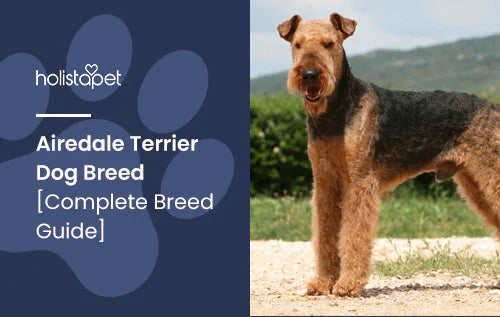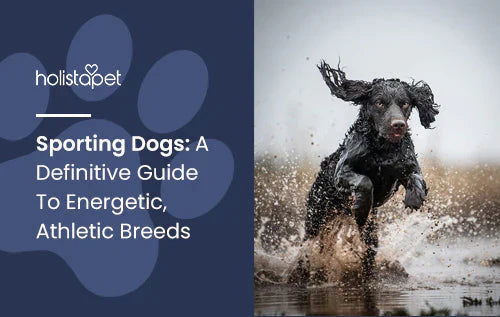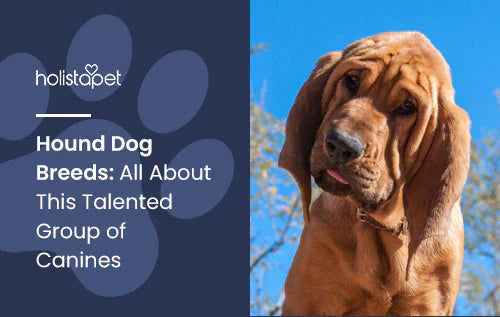If it's not a Lakeland Terrier or a Welsh Terrier, it has to be an Airedale! The Airedale Terrier is an incredibly friendly and intelligent dog breed. These talented Terriers have performed many jobs over the years, and they've excelled at them all.
This guide has everything you need to know about Airedales, "The King of Terriers." Let's get to meet this friendly and courageous dog breed!
Airedale Terrier Characteristics (Physical)
Airedale Terriers are well-built, athletic dogs. They have strong bodies and straight legs that allow them to play and run for long periods. Airedales also have long, flat skulls with deep chests that give them a very regal look.
Airedales also sport a black and tan, medium-length coat made of hard, dense, and wiry hairs. This breed is a good choice for those with allergies because their coat is hypoallergenic. They also have V-shaped ears and a long, fluffy tail that stands erect.
Related: The Best Hypoallergenic Dogs For People with Allergies
Airedales share many characteristics with two other Terrier breeds: Lakeland and Welsh Terriers. All three breeds originated from the Old English Black and Tan Terrier. This Black and Tan Terrier is the foundation of most modern Terriers, but these three dogs resemble their ancestor the closest.
The average life expectancy of an Airdale Terrier is about 12 years. This is typical of many dog breeds in the Terrier group. Some believe the Airedale's large size gives it a slightly longer life expectancy, but even the small Norfolk Terrier typically reaches 12 years of age.
Airedale Terrier Size
The Airedale Terrier Club of America's breed standard states that male Airedales should measure 21-23 inches in height. Females are generally on the shorter side. Airedales have a wide weight range—a small female could weigh 45 pounds, and some large males weigh up to 70 pounds!
Of all the Terrier Breeds, the Airedale is the largest. Their size and fearlessness have earned the Airedale the nickname "The King of Terriers." According to the Airedale Terrier Club of America, both sexes should be sturdy and well-muscled.
Airedale Terrier Personality
The Airedale Terrier is a friendly pet that gets along well with people and other animals. Many dogs in the Terrier group are aggressive with strangers, but that's generally not an issue with this friendly pooch. Most Terrier breeds serve as watchdogs and ratters. This endowed them with a high energy level, a personality that is distrusting of strangers, and a tendency to chase small animals.
However, Airedale Terriers have performed more jobs than the average Terrier. While it may be prone to chasing small animals and digging holes in the yard, the Airedale's versatile employment has helped round out its social skills. Though, socialization training for puppies is still extremely important for all breeds.
Even after they reach adulthood, Airedales tend to hold onto their puppy mindset longer than other breeds. Get your Airedale used to commands, basic training, and mingling with other dogs (especially smaller animals) as a puppy to avoid difficulty when they're adults.

Airedale Terrier Exercise
The Airedale has high energy levels and lively personalities, but it is a joy to help this breed satisfy its physical needs. Some breeds, such as the Afghan Hound, need wide open spaces to break into a full run for proper exercise. However, Airedales can get a healthy workout right from home!
The Airedale needs about 40 minutes to an hour of light exercise every day. Make sure to take some time in your busy schedule to build a consistent routine with your Airedale, going for walks or runs when it is most convenient. Alternatively, you can find a dog park where your Airedale can run off-leash (must be well-trained!) and mingle with other dogs.
No matter how your Airedale stretches its legs, consistency is ideal. The best thing for its health is a good routine that ensures your pet regularly gets the exercise it needs. A routine is also a great way for your dog to anticipate walks and playtime!
If a busy workload or a rainy day messes with your schedule, don't worry. Airedales love playtime with the family. Playing at home is a good source of exercise, though puppies should be supervised if they're with young children or other small animals.
Airedale Terrier Training
Airedales are good at most things they set their mind to, and all they need is some training. This breed often competes in conformation shows, agility events, and several other sporting competitions. Airedale Terriers respond exceptionally well to training, and with some hard work, your Airedale is sure to impress.
Airedales are very intelligent animals that can learn commands and tricks easily! The most important thing to remember is that positive reinforcement is the best way to train your dog. Associating new commands and tricks with positive rewards and praise can quickly help your dog learn. Just remember to not get discouraged if they don't learn right away!
Before focusing on their athletic abilities, you'll first need to determine whether your Airedale needs socialization training. Since these are some of the friendliest dogs in the Terrier group, most Airedales will get along naturally from the get-go. Though, an adult Airedale can be difficult to train if not socialized as a puppy.
Socialization is great for introducing new sights, sounds, people, and pets to young puppies. New experiences and situations will help them adapt and behave to whatever life throws at them in the future. You can start socialization training as soon as eight weeks old!
Airedale Terrier History
The Airedale Terrier comes from Yorkshire, England. Specifically, they originated in the valley of the River Aire or Aire Valley. "Dale" is another word for valley, which is how the Airedale Terrier got its name. Early Airedales were also seen in Bingley, England. In some parts of the world, Airedale Terriers are still called Bingley Terriers.
Airedale Terriers are descendants of the Old English Black and Tan Terrier. Airedale Terrier made fine watchdogs, ratters, and hunting companions. Since Airedales are large for their breed, they are one of the few Terriers capable of hunting big game.
The Airedale has also served as a police dog, guide dog, and even a war dog back in World War I. Airedales would carry messages and mail to soldiers behind enemy lines. Their bravery on the battlefield caused the Airedale's popularity to skyrocket after World War I.
The official kennel club for this breed, the Airedale Terrier Club of America (ATCA), was founded in 1900. To this day, the Airedale Terrier Club of America represents the breed standards for these English dogs. The organization is also the official spokes-organization for Airedales with the American Kennel Club (AKC). The ATCA is also the official Parent Club affiliated with the AKC.

Airedale Terrier Health Problems
Although they are talented and generally healthy, Airedale Terriers can get sick like any other breed. One of the best prevention methods for many conditions is to find a responsible breeder. A good breeder tests their stock for congenital diseases to minimize a puppy's risk of being born with health problems.
The American Kennel Club (AKC) and the Airedale Terrier Club of America recommend that a breeder or an owner perform a hip evaluation, cardiac exam, renal disease DNA test, and ophthalmologist evaluation.
Let's take a look at some common health concerns for the King of Terriers.
Hip Dysplasia
Hip dysplasia is a congenital condition in which the thighbone is misaligned with the hip joint. This skeletal condition is most commonly seen in larger dog breeds. Since the Airedale is the largest Terrier dog, they are at a higher risk of inheriting this disease.
Hip dysplasia can cause the ball of the thighbone and the socket of the hip joint to rub against one another and deteriorate the bone over time. If not treated, the dog may lose the function of its hip joint. Symptoms include decreased activity, pain, stiffness of the rear legs, and a bunny-hopping walk.
Since this is an inherited disease, the best prevention method is to find a responsible breeder. Treatment methods can involve weight loss, physical therapy, joint supplements, and anti-inflammatory medications. In more serious cases, surgery may be able to resolve the issue.
Hypothyroidism
The thyroid gland in our dogs has a direct effect on several different bodily functions. If the animal suffers from hypothyroidism, this means its thyroid is not producing enough hormones. This common condition results from the thyroid shrinking or growing in size.
Hypothyroidism symptoms include hair loss, a dull coat, excessive shedding, weight gain, lethargy, and sensitivity to cold temperatures. If you think your Airedale is suffering from this disease, blood tests can help provide a more accurate diagnosis. A dog affected with hypothyroidism can take supplemental hormones to balance out their bodies.
Progressive Retinal Atrophy (PRA)
Progressive retinal atrophy (PRA) is a condition that steadily wears away at a dog's vision, eventually leading to complete blindness. PRA is an inherited disease. Those who breed responsibly can use DNA tests to determine if a dog will pass the gene that causes PRA to their offspring.
If your Airedale develops PRA, vision loss is the most notable symptom. Other signs include a sudden fear of the dark or a failure to recognize previously familiar family members. A dog with fully-developed PRA is entirely blind, and there is currently no cure for the condition. Luckily, dogs can learn to live and thrive despite being blind.
Umbilical Hernia
An umbilical hernia is the protrusion of the abdominal lining, fat, or organs around the umbilicus (navel). This congenital condition typically ranges from mild to severe. Some small umbilical hernias can be left untreated as they occasionally close without medical intervention.
Even if a small hernia doesn't close, some dogs can live with this condition their entire lives. Surgery can help treat larger hernias. Symptoms include pain, swelling, vomiting, loss of appetite, and depression.
Von Willebrand's Disease
Von Willebrand's disease is a blood disorder that occurs when the Airedale lacks a specific protein that allows blood cells to clot together and seal broken blood vessels. This inherited blood disorder is usually diagnosed when the dog is between 3-5 years old.
Signs of this disease are nosebleeds, bleeding gums, and blood in the stool. There is currently no cure for Von Willebrand's disease, but you can manage it with help manage it with cauterization, blood transfusions, and medication.
Hemorrhagic Gastroenteritis (HGE)
Hemorrhagic gastroenteritis is a condition when large amounts of fluid leak into the stomach or gut area. There is no known cause for this condition, and it can be difficult to diagnose since some other diseases mimic the same symptoms. Treatment involves intravenous fluids, antibiotics, and anti-ulcer medicine.
Hemorrhagic gastroenteritis can be fatal if not treated. Though it can be tricky to spot, you should immediately take your Airedale to the veterinarian if they show signs of vomiting, bloody diarrhea, abdominal pain, lack of energy, or sudden collapse.

How to Care for an Airedale Terrier
The Airedale Terrier does not possess the grooming, nutritional, or physical requirements that some other breeds need to satisfy. Regular exercise, proper nutrition, and routine grooming are the best habits for your Airedale's health.
Remember that they need plenty of exercise every day to burn off excess energy. In many cases, having too much energy can lead to destructive behaviors around the house.
The Airedale loves to dig, so to avoid accidents, be sure to check your yard for holes before letting a child outside. Since the Airedale was a watchdog and ratter in previous years, it could see another small pet as an intruder.
Nutrition and Feeding for Airedale Terrier
Airedales generally do well with 1.5 - 2.5 cups of high-quality dry dog food every day. Split this amount into two meals, giving your Terrier one meal before starting your day and another in the evening. Splitting meals prevent digestive issues and help the dog maintain its weight.
It is also important to find a dog food that is suitable for your pet's age. Puppy food is geared towards the nutritional needs of dogs that are still growing. This means that kibble designed for puppies has more nutrients and calories per bite than chow made for adult dogs.
Many dog breeds do just fine with their bowls set right on the ground, but the Airedale is a larger canine. Dogs should not have to stretch their necks into any uncomfortable positions to eat. Luckily, there's a good general guideline for selecting the right bowl height for dogs.
To find the perfect size, you'll want to measure your Airedale from its paws to the top of its shoulders as it stands. Subtract 5 inches, and this should be the perfect bowl height. Since Airedales typically stand 23 inches tall, a good bowl would be about 18 inches off the ground.
Coat Color And Grooming
The Airedale Terrier coat is usually black and tan. However, there is occasionally a small amount of red mixed in with the black and tan. Some Airedales have a small white star on their chest.
The Airedale has a double coat made up of the harsh, wiry topcoat and a soft undercoat. The iconic Terrier coat usually requires a unique method of grooming known as hand stripping. This is the practice of gently tugging at your Airedale's fur and removing any loose hair.
Why hand stripping? The Airedale's coat grows hair differently than other dogs. Typically, the top layer of the coat is trimmed to remove any dead hair.
However, the Airedale's hair grows thicker and darker the longer it gets, and dead hair may still be connected to the dog's body. Only by removing the hair at the root can the Airedale's coat appear bright and vibrant. This is especially important for any dog being groomed for the show ring.
Otherwise, you can groom the Airedale like any other breed. Use dog shampoo and conditioner and brush their coat regularly (once or twice a week). Make sure you don't bathe the Airedale too often because this can dry out their skin. Instead, bathe your dog as needed. If the dog competes in conformation events, give them a good scrub the night before.
Related: How to Bathe a Dog: A Step-By-Step Guide for Responsible Owners

Children And Other Pets
Airedale Terriers are incredible family pets. They might need supervision around children and other small animals when they're puppies, but proper socialization training can do away with any aggressive behaviors. Generally, the Airedale is a friendly and fun-loving breed.
Children who have not been trained to handle dogs properly should be closely supervised when left alone with Airedales. Even though the breed is friendly, they may become aggressive if a child mishandles them.
The first time your Airedale Terrier meets the rest of the family, try to keep the dog in a single, closed room. Let one pet or person or pet into the room at a time to avoid overwhelming them. Lower your voice to soothe the animals, and keep a leash on the Airedale so that you can end things if they go south.
Airedales have a strong hunting instinct, and they are highly likely to chase down small prey, such as cats, rabbits, gerbils, and hamsters.
Rescue Groups
The Airedale Terrier Adoption and Rescue network is a great rescue group dedicated to saving abandoned or homeless Airdale Terriers. The Airedale Terrier Club of America is also one of the main sponsors for this volunteer-based rescue group. If you are looking to adopt your own Airedale, rescue groups are a great place to check out first!
Petfinder is another fantastic resource for prospective pet owners. Petfinder allows you to search by coat color and hair length. More interested in a puppy? Their website also lets you filter your search by age as well.
A rescue group will often operate locally and pull Airedale Terriers scheduled to be put down from nearby shelters. The American Kennel Club (AKC) has over 450 Rescue Network groups across the United States.
Breed Organizations
The largest kennel club in the world is the American Kennel Club (AKC). Their Parent Club for the Airedale Terrier, the Airedale Terrier Club of America, is the best place to find breed information, news about events, and they can even help you find a breeder.
Registering your dog with a breed organization is the best way to preserve its lineage, protect the Airedale, and connect with other dog owners. The Airedale Terrier Club's mission statement is to encourage quality breeding, solidify the breed standard, and inspire sportsmanship in shows.

More About This Dog Breed
Did you know that Airedale Terriers are believed to be the first police dogs used by Germany and Great Britain? Airedales have long been recognized for their versatility and intelligence. They combine the alertness of Terriers with the height of a large dog breed, resulting in incredibly well-rounded dogs.
Purchase your very own Airedale from Petfinder or a rescue group for this breed. Make sure you register it with a kennel club like the Airedale Terrier Club of America. The average price of an Airedale Terrier puppy can cost anywhere from $800-1500, while higher quality pups can cost as much as $2500!
You're now the proud owner of an impressive dog, and considering their talent and history, the Airedale is truly the King of Terriers!







![Probiotics For Dogs [Soft Chews] - HolistaPet](http://www.holistapet.com/cdn/shop/files/Probiotic-Infographic-1_472d7a29-e30c-435a-9638-1365d8c3a9f9.jpg?v=1725384841&width=104)



























Leave a comment
All comments are moderated before being published.
This site is protected by hCaptcha and the hCaptcha Privacy Policy and Terms of Service apply.